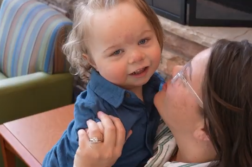NEW YORK, N.Y. (Ivanhoe Newswire)— Last year, an estimated 2.3 million people were diagnosed with breast cancer. Inherited gene mutations, known as BRCA one and two, are found in about five percent of all breast cancer patients. But researchers say the results of a stage three clinical trial may mean more options for these patients diagnosed at an early stage. OlympiA trial
A woman who tests positive for the BRCA one or two gene has a 60 to 70 percent chance of developing breast cancer in her lifetime. These patients are also one and a half times more likely to have cancer come back.
“What they wanted to do in the OlympiA trial is take those patients who are BRCA positive and give them a PARP inhibitor to see if it would prevent recurrence,” Adam Brufsky, MD, PhD, co-director of the Comprehensive Breast Cancer Center at UPMC Magee-Women’s Hospital, told Ivanhoe.
As part of the trial, the PARP inhibitor, Olaparib, also known as Lynparza, was given to 1800 patients with early stage, BRCA one and two positive, HER2- negative cancer. Patients took the drug for a year after chemotherapy.
Dr. Brufsky shared, “They get chemo, have residual disease, get the drug and have survival. I think it was like 85 percent at three years versus 77 percent. It was pretty substantial, 6 percent is a lot in our business.”
Lynparza is currently FDA approved in the U.S. for use in patients with metastatic breast cancer but had not been fully studied in women with early-stage cancer until now.
“This we believe is probably going to change the standard of care,” Dr. Brufsky exclaimed.
Dr. Brufsky said fewer women on Olaparib had less incidents of the cancer spreading and there was a suggestion that there were fewer brain metastases and in general breast cancer. OlympiA trial
Contributors to this news report include: Cyndy McGrath, Producer; Kirk Manson, Videographer; Roque Correa, Editor.
To receive a free weekly e-mail on medical breakthroughs from Ivanhoe, sign up at: http://www.ivanhoe.com/ftk
Sources:
MEDICAL BREAKTHROUGHS
RESEARCH SUMMARY
TOPIC: OLYMPIA TRAIL: LYNPARZA STOPS EARLY BREAST CANCER FROM COMING BACK
REPORT: MB #4939
BACKGROUND: Cancer starts when cells begin to grow out of control. Breast cancer cells usually form a tumor that can often be seen on an x-ray or felt as a lump. Breast cancer occurs predominantly in women, but men can get it, also. Most breast cancers begin in the ducts that carry milk to the nipple (ductal cancers). Some start in the glands that make breast milk (lobular cancers). There are also other types of breast cancer that are less common like phyllodes tumor and angiosarcoma. A small number of cancers start in other tissues in the breast. These cancers are called sarcomas and lymphomas and are not really thought of as breast cancers.
(Source: https://www.cancer.org/cancer/breast-cancer/about/what-is-breast-cancer.html)
BRCA1 AND BRCA2 GENES: There are two different genes that have been found to impact a person’s chances of developing breast cancer, known as BRCA1 and BRCA2. Every person has each of these genes. The BRCA genes help repair DNA breaks that can lead to cancer and the uncontrolled growth of tumors. Because of this, the BRCA genes are known as tumor suppressor genes. In some people, these tumor suppression genes do not work properly. When a gene becomes altered or broken, it doesn’t function correctly and is called a gene mutation. A small percentage of people carry mutated BRCA1 or BRCA2 genes. When a BRCA gene is mutated, it may no longer be effective at repairing broken DNA and helping to prevent breast cancer. The carrier of the mutated gene can also pass a gene mutation down to his or her offspring.
(Source: https://www.nationalbreastcancer.org/what-is-brca)
NEW STUDY IN BREAST CANCER TREATMENT: Scientists have identified a mutation that gives cancer cells resistance to the breakthrough cancer treatment olaparib, and other PARP inhibitors. The findings could help predict which patients will develop resistance to PARP inhibitors and allow doctors to alter treatment at the earliest possible opportunity. The scientists used new ‘CRIPSR-Cas9’ gene editing technology to generate mutations in small, targeted sections of the PARP1 gene, and tagged the mutant protein with a fluorescent protein so their effects could be tracked. This approach allowed the researchers to observe the effect of specific mutations on PARP1 and on the sensitivity of cancer cells to PARP inhibitors. The researchers found that, contrary to their original predictions, cancer cells with certain mutations in the BRCA1 gene could survive this loss of PARP1’s DNA repair function, making them resistant to PARP inhibitors.
FOR MORE INFORMATION ON THIS REPORT, PLEASE CONTACT:
CYNDY PATTON
412-415-6085
If this story or any other Ivanhoe story has impacted your life or prompted you or someone you know to seek or change treatments, please let us know by contacting Marjorie Bekaert Thomas at mthomas@ivanhoe.com




